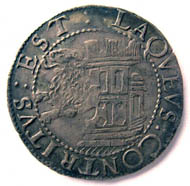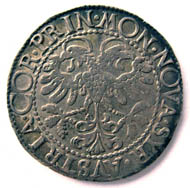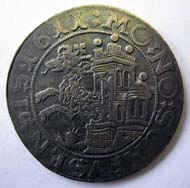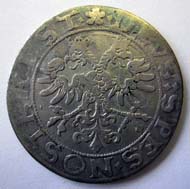From the middle of the sixteenth to the first half of the seventeenth century existed a prosperous industry of imitation of European coins in Northern Italy and the Netherlands. Coins renowned for their popularity and correct weight were copied in base silver and slightly under weight.
Imitation of a Schaffhausen dicken by Prince Siro of Austria (1616-1630) from Correggio (Italy). Testone (6.85 g) no date. MON NOVA SYR AVSTRIA COR PRIN double-headed eagle with nimbus. Rv. LAQVEVS CONTRITVS EST Lion jumping from a tower to left. (CNI IX, 67; Kunzmann 28,1 g; Gamb. 46). Copyright Sturzenegger Stiftung / Museum zu Allerheiligen Schaffhausen.
Running that operation on a grand scale and imitating many different coin types one was able to make a good profit. Thus the princes of the principalities of Northern Italy recruited agents who travelled to Switzerland, the Lake Constance and Southern Germany. With them they would take imitated coins purchasing expensive goods with cheap money. Two factors came in handy: Many of those they paid with bad coins were illiterate and hence could not read the inscriptions; and in these times so many different types of coins circulated in Central Europe that nobody could keep track of them except the professional money changers. And even they had to fall back on books to distinguish good coins from bad ones.
SCHAFFHAUSEN. Dicken 1611. MO NO SCAFVSENSIS 1617 Coat of arms of Schaffhausen: Ram jumping from a tower. Rv. DEVS SPES NOSTRA EST Double-headed eagle. © Museum zu Allerheiligen / Schaffhausen.
Naturally the authorities would regularly complain to the producers about the fallacious coins. But these had excellent pretexts on hand. Actually they never copied the inscription precisely, and they used to alter slightly the images, too. So the Schaffhausen ram became a lion or a lily was substituted by a quince and so on. Furthermore the princes had not to be afraid of much. They enjoyed the privilege of Imperial immediacy and that means that only the Emperor himself could sit in judgment over them. And in the sixteenth and seventeenth century the Emperor was very very far away. Besides, from an economic point of view they had pretty little choice. Their principalities usually were small and the revenue from taxes low. Thus, if these noblemen desired to maintain the level of lifestyle they considered adequate – a lifestyle realized by the noble houses of the rich trade cities – they had to be pretty resourceful.
This situation ended only when the German Emperor and the Pope intervened seriously – under pressure from the Dukes of Savoy and the cities of Milan and Venice. Some nobles, like the princes of Correggio who had initiated the Schaffhausen imitations, lost everything. They were adjudged a penalty so high they were forced to sell their principality.









